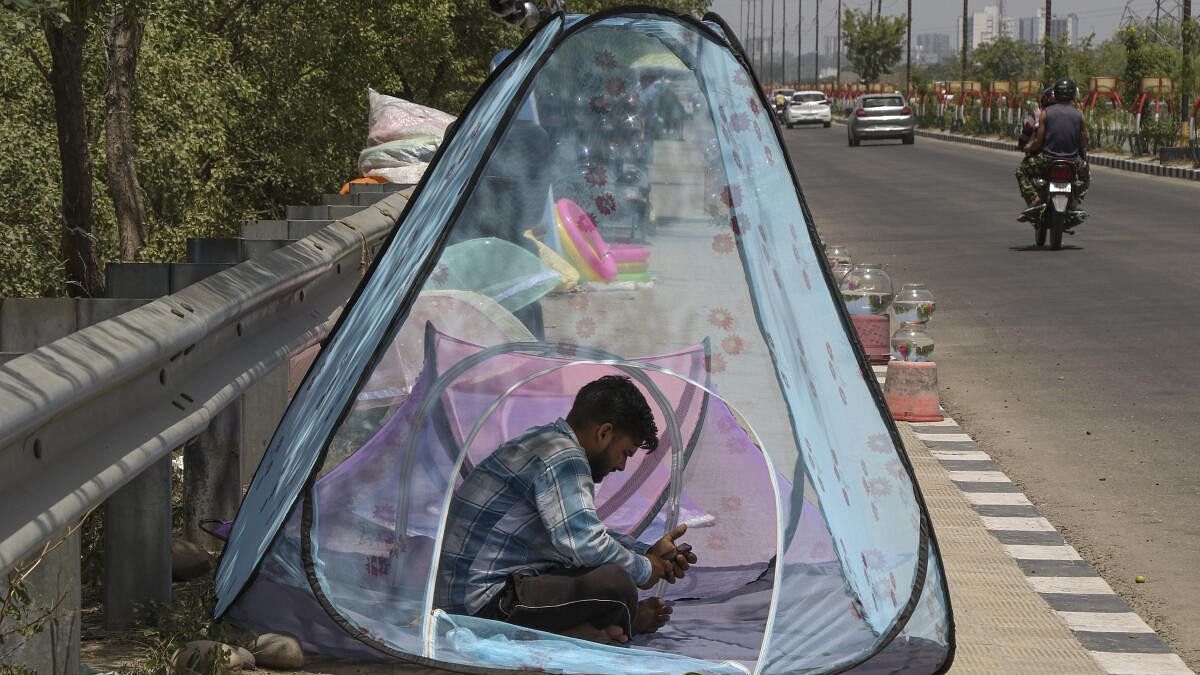
A vendor sells mosquito nets on a hot summer day.
Credit: PTI Photo
New Delhi: The extreme heat scorching large parts of northwest India will continue for another five days, with Delhi, Haryana, Punjab, Rajasthan and Uttar Pradesh predicted to bear the maximum impact.
A brutal heat wave swept swathes of north India on Friday, with the maximum temperature soaring to a scorching 47.4 degrees Celsius in southwest Delhi's Najafgarh, the highest this season in the country so far.
The India Meteorological Department (IMD) on Saturday predicted a severe heat wave over the plains of northwest India during the next five days and a heat wave over the east and central regions during the next three days.
The Met office also issued a red warning for Delhi, Haryana, Punjab and west Rajasthan, stressing the need for 'extreme care for vulnerable people'.
It issued an orange alert for east Rajasthan, Uttar Pradesh and Bihar and emphasised 'high health concern' for vulnerable people, including infants, the elderly and those with chronic diseases.
The Met office said high humidity could add to people's inconvenience in Goa and sub-Himalayan West Bengal.
The IMD also said warm night conditions are likely in Uttar Pradesh, Bihar and west Rajasthan over the next two-three days. High night temperatures are considered dangerous because the body doesn't get a chance to cool down.
Increasing nighttime heat is more common in cities because of the urban heat island effect, in which metro areas are significantly hotter than their surroundings.
In view of the general elections in India, experts have warned of an increased likelihood of heat-related illnesses in people exposed to the sun for prolonged periods or engaging in heavy work.
Researchers at Climate Central, a US-based group of climate scientists, said 543 million (54.3 crore) people in India will experience at least one day of extreme heat during May 18-21.
'Human-caused climate change has made this intense heat much more likely. The high overnight temperatures make this event particularly alarming,' said Andrew Pershing, vice-president for science at Climate Central.
Heat waves can be deadly, with the elderly and children particularly at risk of heat exhaustion and heatstroke.
According to the World Health Organization, more than 1,66,000 (1.66 lakh) people died as a result of heat waves between 1998 and 2017.
Extreme temperatures can also impact economies. People are less productive during hot weather, even if they work indoors, while children struggle to learn in extreme heat.
A 2022 study said extreme heat resulted in labour productivity loss of USD 2.1 trillion equivalent in 2017.
On Friday, maximum temperatures surged to 47.4 degrees Celsius in Najafgarh and 47.1 in Haryana's Sirsa.
According to India Meteorological Data (IMD) data till 7:30 pm, Najafgarh was the warmest place in the country.
Before this, Kalaikunda in the Gangetic West Bengal region had recorded a high of 47.2 degrees Celsius on April 30.
The threshold for a heat wave is met when the maximum temperature of a weather station reaches at least 40 degrees Celsius in the plains, 37 degrees in the coastal areas, and 30 degrees in the hilly regions, and the departure from normal is at least 4.5 notches.
A severe heat wave is declared if the departure from normal exceeds 6.4 notches.
April witnessed record-smashing maximum temperatures in east, northeast, and southern peninsular India, prompting health warnings from government agencies and a few states to suspend in-person classes in schools.
Several places recorded their highest-ever April day temperatures, with the mercury soaring to 47 degrees Celsius.
At least two people died in Kerala due to suspected heatstroke during this period.
On Wednesday, a group of leading climate scientists said similar heat waves could occur once every 30 years, and these have already become about 45 times more likely due to climate change.
The scientists from the World Weather Attribution group emphasised that heat waves intensified by climate change are making life much tougher for people living in poverty across Asia.
The IMD had earlier warned of extreme heat in India during the April-June period, coinciding with the seven-phase Lok Sabha elections that end on June 1.